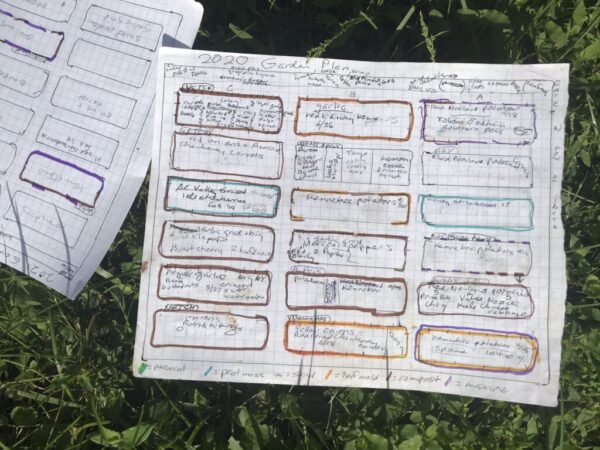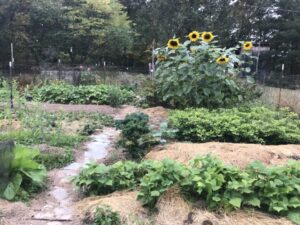- Like
- Digg
- Del
- Tumblr
- VKontakte
- Buffer
- Love This
- Odnoklassniki
- Meneame
- Blogger
- Amazon
- Yahoo Mail
- Gmail
- AOL
- Newsvine
- HackerNews
- Evernote
- MySpace
- Mail.ru
- Viadeo
- Line
- Comments
- Yummly
- SMS
- Viber
- Telegram
- Subscribe
- Skype
- Facebook Messenger
- Kakao
- LiveJournal
- Yammer
- Edgar
- Fintel
- Mix
- Instapaper
- Copy Link
 A version of this column first ran in the Roane County (WV) Reporter and Times Record. Support local journalism! Subscribe to your local newspaper. This is one of a series of blogs for new gardeners. Start reading the whole series here: Part 1.
A version of this column first ran in the Roane County (WV) Reporter and Times Record. Support local journalism! Subscribe to your local newspaper. This is one of a series of blogs for new gardeners. Start reading the whole series here: Part 1.
First of all—in case you didn’t read my first column back in April—here’s a refresher on why you might want to plan on a garden next year, even if you didn’t plant one this year.
This column focuses on vegetable and fruit growing, not ornamentals, and the top reason for a garden is to have fresh food you know has had no chemicals sprayed on it. So it’s a matter of quality… but it’s also a matter of security. It’s good to have some food in your backyard in case our journey in the handbasket speeds up, and either grocery stores can’t be relied upon or you don’t have cash to spend in them. Even if things stay normal, it should save you money. And the skills and tools you acquire now may come in handy in some later year.
There are lots of other reasons to garden besides the obvious one of getting the produce. There is the soothing quality of the work, surrounded by nature. Here in Appalachia we are blessed with a multitude of pretty birds and plants and animals, and four delicious seasons—to appreciate all this bounty, you need to spend time outside! Hear the birds, smell the moldering leaves of fall and the flowering shrubs of spring, snatch a tomato or pea to eat right in the garden in summer, apologize to a toad unearthed while preparing ground. I‘ve actually read a couple of times that there are organisms in soil with antidepressant qualities (no, I don’t wear gloves when working in the garden). Actually, I’ve found that having a bright green plant in my window all winter cheers me up—just looking at something green seems to have an anti-depressant function. Gardening also involves exercise, always a good thing for mood and health. And it exposes you to sunlight, and thus vitamin D, which is important for mood and for immune function. It’s satisfying to work with nature to turn a seed into a seedling, and then into a plant, which eventually bears fruit of some kind. Some crops will be failures—but that keeps it interesting.
I hope we’ve answered the first question—should I have a garden next year—in the affirmative. Now my advice divides according to whether you had a garden this year.
If you did, the question is how to ready it for winter—how to make preparations now for next year’s garden. The first principle is: don’t leave the remains of this year’s crops on the ground, especially if they had any disease or insect pests. Other than seriously diseased plant matter, it should all go in the compost—so you’ll have compost to work with next spring, or next summer at the latest.
However, another important principle is: don’t leave the soil bare. That leaves it open to erosion. Covering it also makes it more hospitable to the myriad organisms hard at work all winter improving the soil. But you ask: cover it with what? You have two main choices—cover crops and mulch. The mulch could be leaves or compost but will more likely be hay. I recently did a whole column on cover crops, so I’ll say here only that it’s getting late to plant any but rye and vetch.
Before using cover crops or mulch, you have the option of getting the ground ready for next year. In my garden with its permanent raised beds, I do this on an individual bed basis, readying the soil for the crop I plan to put there next year. If you don’t use permanent beds, you might till and work in any soil amendments now, and then cover it with your straw or planting your cover crop. This way the ground will be ready earlier in spring, especially with raised beds, which dry out faster. Rye is not easy to turn under, however, especially in clay soil. For this reason, I mostly use vetch and winter peas in the vegetable garden with raised beds, and use rye or wheat mainly in the flat ground I call Central. That gets tilled in the spring.
What if you didn’t have a garden this year? In that case, your first task is to decide on location. You want, of course, full sun if you can get it, and relatively flat ground. I don’t mean perfectly flat ground, this ain’t Iowa. But steeply sloping ground is subject to erosion and hard to work.
After choosing your garden space, next you need to do some soil preparation. Probably you will till the ground, ideally you will consult the Extension about a soil test, and then you add your amendments—manure, compost, possibly sand, perhaps some lime or wood ashes if the soil tests below 6.2 pH. (If you’re going to use commercial fertilizer, wait until spring to apply it.) Then you cover the ground in the same ways mentioned above. A fence is pretty much a necessity to keep deer, rabbits, groundhogs and various other varmints out, but that can wait until spring.
There is another approach to starting a new garden, in which you never till the ground. Sometimes it’s called lasagna gardening. You lay down cardboard over the ground you want your garden to cover, and then add layers of soil and organic matter or various sorts, including compost which need not be finished decomposing. Then you can plant right in the surface. I tried this when I started my garden here 11 years ago, only to rake up all the cardboard and amendments and till the ground, because the catch is you need something like a foot of all this organic matter and soil—and where can you get so much compost? Since I only had about three inches worth, I had my husband run the tiller, and then I raked the topsoil into beds. This way the pathways are left with hard, poor soil—all the better to slow their weed growth. The beds are built up with the topsoil from the pathways, as well as the amendments you procured.
I should mention that you can buy bags of compost, topsoil and manure, but it isn’t clear what you’re getting when you buy your topsoil in bags. Even the organic cow manure is, I believe, not inspected like organic food is. I once read that some unscrupulous manufacturers bagged up toxic byproducts and sold them as fertilizer, so I have bought bags of cow manure but I prefer to avoid that when I can get manure locally, along with using my own compost and leafmold. Peatmoss has some questions about its sustainability, and is the one additive that renders the soil much more acidic…a good thing if you’re starting a blueberry bed but probably not for a vegetable garden.
Read the rest: Part 1. Part 2. Part 3. Part 4. Part 5. Part 6. Part 7. Part 8. Part 9. Part 10. Part 11. Part 12. Part 13. Part 14. Part 15. Part 16. Part 17. Part 18. Part 19. Part 20. Part 21. Part 22. Part 23. Part 24. Part 25. Part 26.













